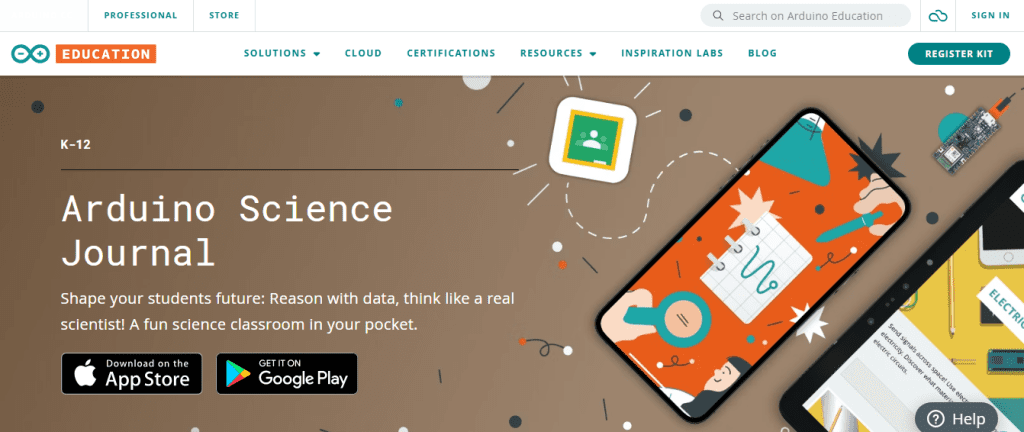The Arduino Science Journal is an innovative and user-friendly app that allows students and teachers to track experiment data, observe results, and learn interactively. Developed by Arduino, this app provides a comprehensive platform for conducting experiments and gathering data about the world around you.
Whether you’re a student conducting a biology experiment, a physics enthusiast exploring motion and forces, or a teacher looking for a tool to engage your students in hands-on learning, the Arduino Science Journal has something to offer. Its intuitive interface, wide range of sensor support, and interactive data visualization features make it a valuable resource for anyone interested in exploring the wonders of science.
How Does It Work?
Once installed, the app offers a range of features and tools to support scientific exploration. Users can create experiments, record observations, and analyze data in real time. There is also a signup option.
The app allows users to connect various sensors, such as light, sound, temperature, and motion sensors, to their Arduino board. These sensors can be used to collect data, which is then visualized in graphs and charts within the app. Users can also add notes, photos, and videos to their observations, making it easier to document and analyze their findings.
Key Features

Here are some key features that make this app a must-have tool for scientists and DIY enthusiasts:
- Experiment Creation: With Arduino Science Journal, users can easily create custom experiments by selecting from a wide range of available sensors and variables. Whether you’re measuring temperature, light intensity, or motion, the app has got you covered.
- Real-time Data Visualization: The app provides real-time visualization of collected data, giving users the ability to observe trends and patterns as they unfold. This feature allows for quick analysis and adjustments during the experiment, ensuring accurate and reliable results.
- Data Analysis: Arduino Science Journal offers powerful data analysis capabilities. Users can dive deep into their experiment data using interactive graphs and charts. This allows for detailed examination of the collected data, helping users draw meaningful conclusions and insights.
- Collaboration: Science is all about sharing knowledge and findings. With the collaboration feature, users can easily share their experiments and findings with others. This fosters a collaborative environment where ideas can be shared, discussed, and improved upon.
- Integration with Arduino Boards: Arduino Science Journal seamlessly integrates with Arduino boards, making it easy to connect sensors and collect data. This integration allows users to leverage the full potential of Arduino’s hardware capabilities while enjoying the convenience of the app’s user-friendly interface.
Benefits to Users

Arduino Science Journal offers several benefits to its users. Firstly, it enhances learning by allowing students to actively engage in the scientific process, promoting a deeper understanding of concepts. Additionally, the app helps develop data analysis skills as students visualize and analyze data, fostering essential skills in data interpretation and analysis. Moreover, Arduino Science Journal provides collaboration opportunities, enabling students to work together on experiments, promoting teamwork and shared learning experiences. Finally, the app facilitates practical application by bridging the gap between theory and practice, allowing students to apply scientific principles in real-world scenarios.
Pros
- Clean and intuitive interface for easy navigation and experiment conduct.
- Wide sensor support for flexibility in experiment design.
- Fosters interactive, hands-on learning with practical engagement in science concepts.
- Users can document observations seamlessly with notes, photos, and videos, creating a comprehensive experiment record.
- The app covers subjects for further explorations.
Pricing and Value for Money
The Arduino Science Journal app is available for free, providing a valuable resource for students and educators. There are also subscription plans available for additional features and benefits. The Maker plan costs $6.99 per month, while the Maker Plus plan costs $23.99 per year and offers enhanced capabilities such as increased data retention and connectivity options.
Conclusion and Recommendation
Arduino Science Journal is a powerful educational tool that empowers students to explore science interactively and practically. With its user-friendly interface, versatile sensor support, and comprehensive data analysis features, this app provides a valuable resource for science education.
This app is highly recommended for students and teachers seeking to enhance their learning experience and delve deeper into scientific exploration. Whether used in the classroom or at home, Arduino Science Journal offers a hands-on approach to learning that inspires curiosity and promotes a deeper understanding of the world around us.
